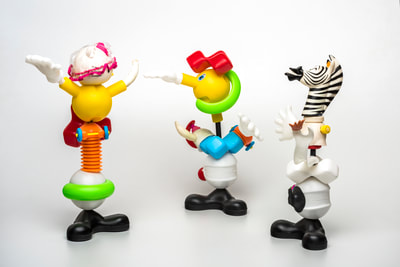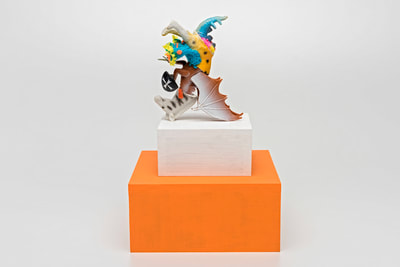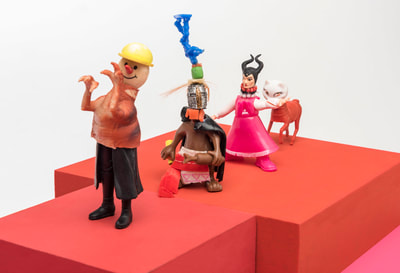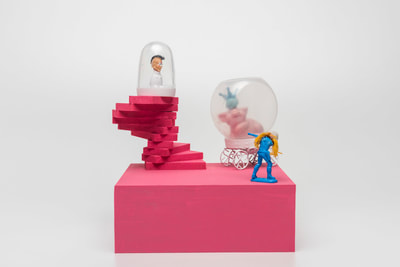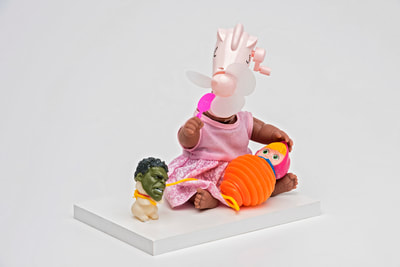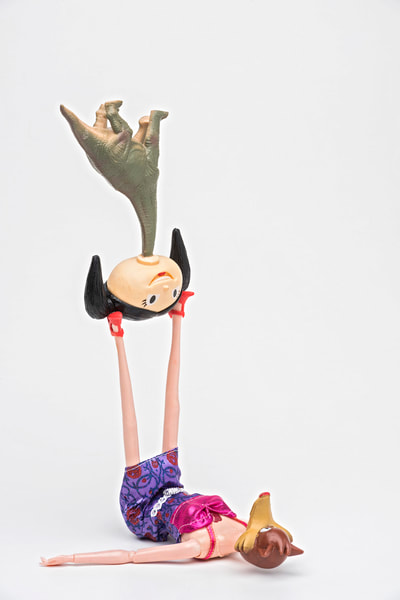November 2018
Member Exhibit
Avilmar Maia
1. The body, the culture: two montages[1]
Avilmar Maia’s work of art uses action figures as the main material. The artist gathers all sorts of miniatures to be disassembled and recombined. They are Surperman, Peppa Pig, Mickey Mouse, characters from Toy Story, Barbie dolls, as well as other unnamed figures which, after going through an intense process of montage, merge into the cheap samples of the most famous characters of the cultural industry that can be found around the city. This process is named “Pulsa” by the artist, a word that designates the whole series of artwork with miniatures and takes us immediately to the pulse, in other words, to the vital impetus that these pieces acquire from the destruction and construction to which the artist put them through. Not just that, subsequently a second montage is created. This time the miniatures are placed in mythological scenes where they are put in an acrylic box and renamed with names of characters from Greek, Judeo-Christian and modern literature, this last one having its origin in the other two mentioned. Therewith, to the natural blow, that is, the one of the blood pulsation which gives life to a body, another blast is added, the cultural one, when the reconfiguration of the new miniatures gesture reminds or enacts mythological passages that are the founders of western culture, and that is finally indicated by the works of art captions.
As an example: “Gaia” is the name given to a scene in which Superman is given the head of Minnie – the female version of Mickey Mouse. Therefore, there are two layers of cut and montage. In the first, the miniatures are as if they were put on a surgery table, where they are decapitated. The figure with a male body, which works as a metonymy of western masculinity, gets the head of an anthropomorphic rat – after all it crystallizes on superman, as if it wants his name, the anthropocentrism allied to the sexism, in which the superpower that permits the unrestrained control of nature and the massacre of the Other, finds its home in the manly body with symmetrical proportions.
_____________________________________________________________
¹ This text is an excerpt from the article by João Guilherme Dayrell – post-doctorate at the Language and Literature Department of the University of São Paulo – USP; PhD in Literary studies and Comparative Literature at Federal University of Minas Gerais – UFMG; master in Literature at Federal University of Santa Catarina – UFSC.
2. The life, the art: montage as surgery
Although “Gaia” brings to bear serious issues from specific references, Avilmar Maia’s entire work is relentless in that, after all, the two assembly processes that his objects go through can simply profane as well as make the mythology or any passage from the bible laughable. What is noticeable, for instance, in “A fuga para o Egito” (The escape to Egypt), in which Joseph, Mary and baby Jesus are, in a small or non-discriminate way, embodied in a female body with the head of a male character from Toy Story sitting on a goat whose body borrows the purple head from another figure and together they pull, in turn, the little Peppa Pig’s head inserted on a tiny carcass of a not specified quadruped. Walter Benjamin once said that “each childhood, with its interest in technological phenomena and its curiosity on all sort of inventions and machines, connects technological achievements to the symbolic ancient worlds”[1]. That is why such montages have a temporal effect once the objects lose their nature of present time, strongly marked by the material from what they are made, such as plastic, and the same happens to characters which they represent such as Peppa Pig. The montages solicit what is primeval: our bodies and their tempers activated by the laughter, and the ancient mythology that founds our culture. In the end, wouldn’t it be something similar to these two aspects that would take us to a montage such as “Édipo e a Esfinge” (Oedipus and the sphinx) in which an indigenous figure, with its bow and arrow ready to be shot, has a woman’s head looking straight to a dark blue frog whose human body, finally, is carried by a light blue dinosaur? It encompasses the comprehension and also the laughter. The construction and deconstruction of meaning are proportional between the criticism and the debauchery.
[1] BENJAMIN, Walter. Passagens, 2009, p. 503.
Avilmar Maia’s work of art uses action figures as the main material. The artist gathers all sorts of miniatures to be disassembled and recombined. They are Surperman, Peppa Pig, Mickey Mouse, characters from Toy Story, Barbie dolls, as well as other unnamed figures which, after going through an intense process of montage, merge into the cheap samples of the most famous characters of the cultural industry that can be found around the city. This process is named “Pulsa” by the artist, a word that designates the whole series of artwork with miniatures and takes us immediately to the pulse, in other words, to the vital impetus that these pieces acquire from the destruction and construction to which the artist put them through. Not just that, subsequently a second montage is created. This time the miniatures are placed in mythological scenes where they are put in an acrylic box and renamed with names of characters from Greek, Judeo-Christian and modern literature, this last one having its origin in the other two mentioned. Therewith, to the natural blow, that is, the one of the blood pulsation which gives life to a body, another blast is added, the cultural one, when the reconfiguration of the new miniatures gesture reminds or enacts mythological passages that are the founders of western culture, and that is finally indicated by the works of art captions.
As an example: “Gaia” is the name given to a scene in which Superman is given the head of Minnie – the female version of Mickey Mouse. Therefore, there are two layers of cut and montage. In the first, the miniatures are as if they were put on a surgery table, where they are decapitated. The figure with a male body, which works as a metonymy of western masculinity, gets the head of an anthropomorphic rat – after all it crystallizes on superman, as if it wants his name, the anthropocentrism allied to the sexism, in which the superpower that permits the unrestrained control of nature and the massacre of the Other, finds its home in the manly body with symmetrical proportions.
_____________________________________________________________
¹ This text is an excerpt from the article by João Guilherme Dayrell – post-doctorate at the Language and Literature Department of the University of São Paulo – USP; PhD in Literary studies and Comparative Literature at Federal University of Minas Gerais – UFMG; master in Literature at Federal University of Santa Catarina – UFSC.
2. The life, the art: montage as surgery
Although “Gaia” brings to bear serious issues from specific references, Avilmar Maia’s entire work is relentless in that, after all, the two assembly processes that his objects go through can simply profane as well as make the mythology or any passage from the bible laughable. What is noticeable, for instance, in “A fuga para o Egito” (The escape to Egypt), in which Joseph, Mary and baby Jesus are, in a small or non-discriminate way, embodied in a female body with the head of a male character from Toy Story sitting on a goat whose body borrows the purple head from another figure and together they pull, in turn, the little Peppa Pig’s head inserted on a tiny carcass of a not specified quadruped. Walter Benjamin once said that “each childhood, with its interest in technological phenomena and its curiosity on all sort of inventions and machines, connects technological achievements to the symbolic ancient worlds”[1]. That is why such montages have a temporal effect once the objects lose their nature of present time, strongly marked by the material from what they are made, such as plastic, and the same happens to characters which they represent such as Peppa Pig. The montages solicit what is primeval: our bodies and their tempers activated by the laughter, and the ancient mythology that founds our culture. In the end, wouldn’t it be something similar to these two aspects that would take us to a montage such as “Édipo e a Esfinge” (Oedipus and the sphinx) in which an indigenous figure, with its bow and arrow ready to be shot, has a woman’s head looking straight to a dark blue frog whose human body, finally, is carried by a light blue dinosaur? It encompasses the comprehension and also the laughter. The construction and deconstruction of meaning are proportional between the criticism and the debauchery.
[1] BENJAMIN, Walter. Passagens, 2009, p. 503.
Avilmar Maia studied sculpture in private studio (2005) and drawing in the Guignard School 92006), in Belo Horizonte City, Brazil. He attended courses about Aesthetics of Art at Inimá de Paula Museum (2007). He studied History of Art and Contemporary Art at the Republic of Art (private studio) in Belo Horizonte City. (2008) and also courses about Theory of Art at Art School in the Federal University of State of Minas Gerais (uFMG) in Belo Horizonte city, Brazil.
He graduated medical school in 1994. Later on, he became a specialist in Psychiatry (1997) and in 2007 he got a master degree in psychoanalysis in the Federal University of State of Minas Gerais (UFMG).
CONTACT:
website: avilmarmaia.org
Email: [email protected]
